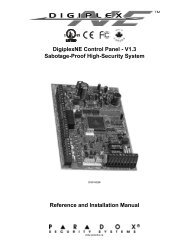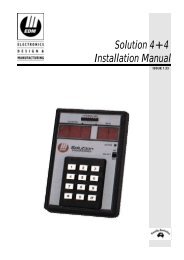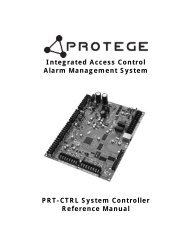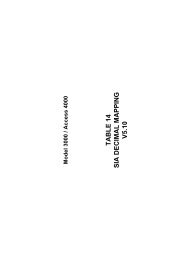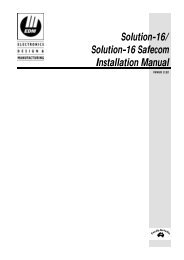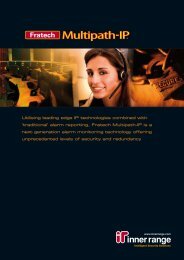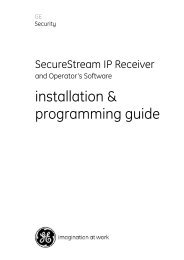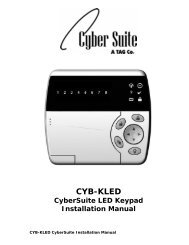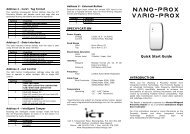PM-Menu-76 Doors - Security Help Desk
PM-Menu-76 Doors - Security Help Desk
PM-Menu-76 Doors - Security Help Desk
You also want an ePaper? Increase the reach of your titles
YUMPU automatically turns print PDFs into web optimized ePapers that Google loves.
[MENU 7-6] p 4<br />
MODEL 3000 / ACCESS 4000 Programmer’s Manual - <strong>Doors</strong>. Rev 4.50<br />
Door Interlocking<br />
ACCESS 4000 ONLY<br />
The Access 4000 model supports convenient Door Interlocking without the need<br />
to programme Calculated Auxiliaries or Function Zones. Every Door can have an<br />
Interlock Group assigned to it. When a Door has an Interlock Group assigned,<br />
access through the Door may be further qualified by the programming of that<br />
Interlock Group. <strong>Doors</strong> can share Interlock Groups if required. The number of<br />
Interlock Groups programmable depends upon the memory configuration.<br />
Special Note:<br />
In order for the 4000 system to correctly sense the state of the door reed switches,<br />
these zones should be placed in an Area which is left on permanently with a benign<br />
Process Group.<br />
D001 Interlock<br />
Group: IL000<br />
Interlock to<br />
program: IL001<br />
This screen allows an optional Interlock Group to be assigned to the Door. If the<br />
group is left at zero, access will not be denied through this Door due to an Interlock<br />
violation, although this door can participate in Interlock decisions for other <strong>Doors</strong>.<br />
If an Interlock Group is specified, it must be programmed to determine the<br />
Interlocking rules.<br />
To programme Interlock Group options, press HELP, “9”.<br />
Door Interlocking Programming<br />
This screen selects which Interlock Group to programme. The number of Interlock<br />
Groups depends on the memory configuration.<br />
See the Applications Programming section for further details.<br />
IL001 T.Zone -><br />
None<br />
IL001 Alt.<br />
Interlock: IL000<br />
IL001 ZT......<br />
Opts-> nnnnnnnn<br />
This screen allows a TimeZone to be applied to this Interlock Group. If a TimeZone<br />
is defined and is valid, this Interlock Group will be active; that is Interlock logic<br />
will be applied. If a TimeZone is invalid then either the Interlock Group will not be<br />
active and no Interlock logic will be applied or, if an alternative group is defined,<br />
that group will be used.<br />
This screen defines an alternative Interlock Group to use if the TimeZone is invalid.<br />
This screen allows certain Interlock Group options to be programmed:<br />
Z<br />
T<br />
Zone Inputs<br />
Tongue Sense<br />
If this option is set to “Y”, an optional Zone Input can be used to qualify Interlock<br />
operation.<br />
If this option is set to “Y”, Tongue Sensing is used in addition to qualify the Interlock<br />
operation.<br />
Note: Do not set to “Y” if Tongue sense inputs not connected. If set to Yes when<br />
not used, & Input/s are not sealed, Interlock logic will not allow <strong>Doors</strong> to un-lock.<br />
. Spare<br />
Spare option for future development. Leave set to “n”.<br />
Copyright exists on this manual. Unauthorised copying of this document is prohibited.



